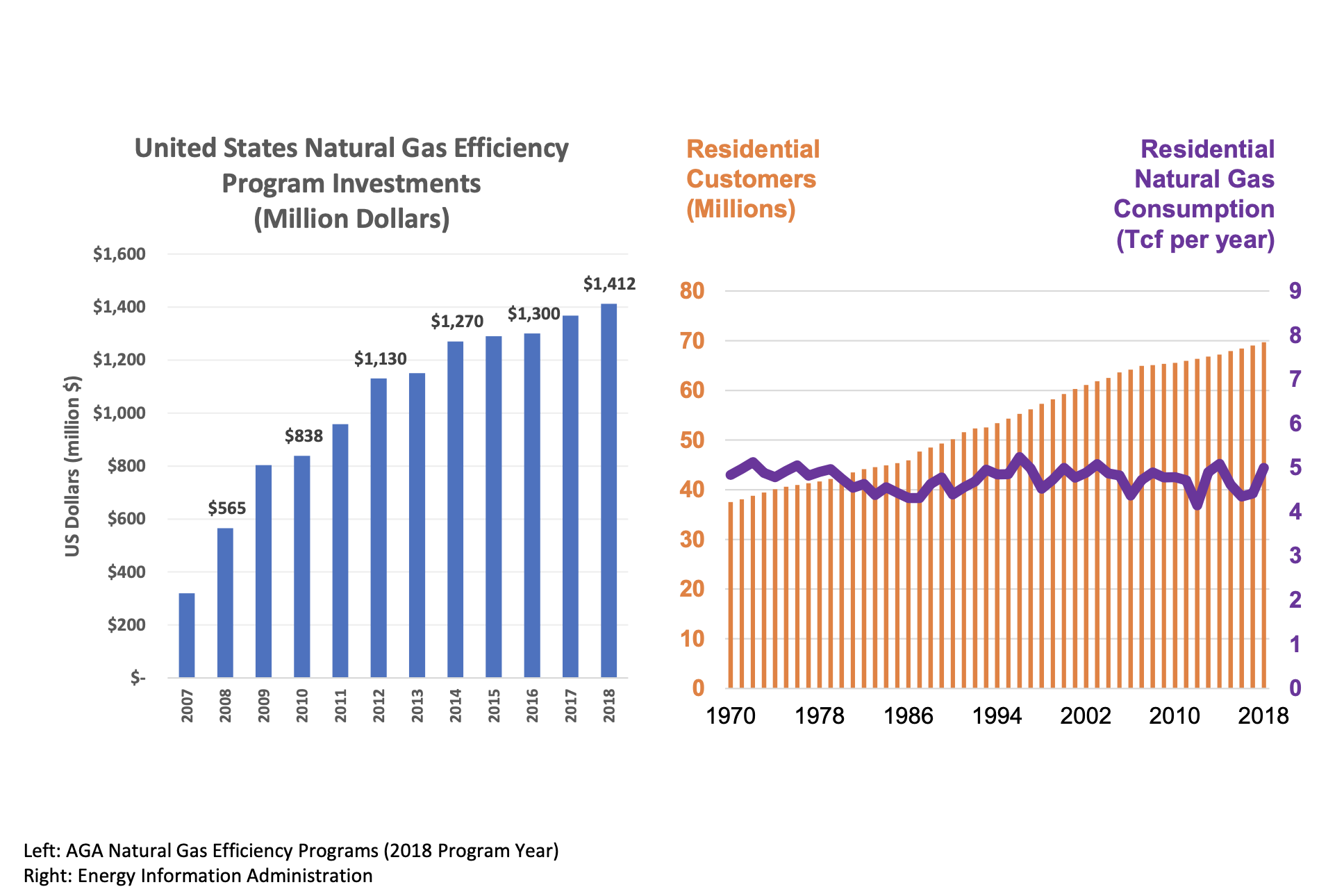Natural Gas Efficiency Programs Pay Off in Reduced Costs, Carbon Emissions
By Jeff Awalt, Executive Editor
(P&GJ) — North American natural gas utilities have been spending nearly $4 million a day for programs to help residential, commercial and industrial customers make more efficient use of the fuel. But how much good does it do?
Quite a lot, the latest American Gas Association study shows.
Those efficiency investments helped natural gas utility customers save 259 trillion Btus of energy and offset more than 13.5 million metric tons of carbon dioxide emissions from 2012 to 2018 – the equivalent to removing 2.9 million cars off the road for a year.
Customers saved 425 million Therms or 42.5 trillion Btu through natural gas efficiency programs, offsetting 2.25 million metric tons of avoided CO2 emissions in 2018 alone.
The efficiency programs also save money for customers, especially those using direct gas for heating rather than electricity. On average, households using electricity for heat during the winter spend twice as much as those with natural gas, according to the U.S. Energy Information Administration.
“So there is real environmental benefit, real economic benefit” to the efficiency programs, AGA President and CEO Karen Harbert said.
“The bottom line is the direct use of affordable natural gas in homes and businesses in these times of Covid is keeping energy affordable. It will be a big part of our economic recovery and really importantly, it is a big part of our nation's climate change solution,” Harbert told reporters after release of the AGA’s “Natural Gas Efficiency Programs Report,” which analyzed nationwide data from the 2018 program year on behalf of its members.
“At its very core, simply put, energy efficiency is a partnership between customers and their utility, obviously with oversight by regulators,” Harbert added. “These programs make it easier and less expensive to do things like installing new doors and windows, having better insulation and introducing more efficient natural gas appliances into your home and your business.”
Illustrating the contributions of improved efficiency, AGA found that overall residential natural gas demand has remained steady over the past 40 years, despite an 86 percent increase in the total number of customers.
Residential natural gas customers use less than half the volume of natural gas today, on average, as they used in 1970, even though the average size of new homes has increased roughly by half in that period. Over the same period, CO2 emissions from the average natural gas-fueled home have declined by 1.2 percent per year, AGA said.
“Energy efficiency is an amazing story, but it's one of the ones that are not as widely talked about” said Sapna Gheewala, manager of Energy Efficiency in AGA’s Energy Markets, Analysis and Standards Group and author of the new study. “It's not a sexy new solar panel or an electric car, but it's going to be especially important going into the future in decreasing the initial energy investment in all sectors as our demand rises and we want to combat climate change and reduce emissions for a cleaner energy future.”
In 2018, natural gas utilities funded 132 natural gas efficiency programs in the U.S. and Canada for a total of $1.47 billion—an 8% increase from 2016 and 20% higher than 2012. The programs ranged from newly launched to mature programs that have been in place for 20 years or longer. More than 50 of the programs had been in place for at least 10 years.
Natural gas utilities focused a quarter of the spending, $365 million, on low-income efficiency programs, assisting more than 214,000 participants in 2018. Additionally, more than 66,000 commercial customers, and upwards of 72,000 industrial program customers were enrolled in natural gas efficiency programs in 2018.
Energy efficiency is a key component of AGA’s Climate Change Position Statement, released earlier this year. The use of natural gas, in combination with renewable energy and efficiency, has contributed to US energy-related carbon dioxide emissions declining to the lowest levels in nearly 25 years, AGA said.
Related News
Related News

- Keystone Oil Pipeline Resumes Operations After Temporary Shutdown
- Biden Administration Buys Oil for Emergency Reserve Above Target Price
- Freeport LNG Plant Runs Near Zero Consumption for Fifth Day
- Enbridge to Invest $500 Million in Pipeline Assets, Including Expansion of 850-Mile Gray Oak Pipeline
- Williams Delays Louisiana Pipeline Project Amid Dispute with Competitor Energy Transfer
- Evacuation Technologies to Reduce Methane Releases During Pigging
- Editor’s Notebook: Nord Stream’s $20 Billion Question
- Enbridge Receives Approval to Begin Service on Louisiana Venice Gas Pipeline Project
- Russian LNG Unfazed By U.S. Sanctions
- Biden Administration Buys Oil for Emergency Reserve Above Target Price





Comments